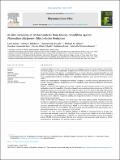| dc.contributor.author | Adams, Latif | |
| dc.contributor.author | Afiadenyo, Michael | |
| dc.contributor.author | Kwofie, Samuel | |
| dc.contributor.author | Wilson, Michael D. | |
| dc.contributor.author | Kusi, Kwadow Asamoah | |
| dc.contributor.author | Obiri-Yeboah, Dorcas | |
| dc.contributor.author | Moane, Siobhan | |
| dc.contributor.author | McKeon-Bennett, Michelle | |
| dc.date.accessioned | 2023-04-06T14:21:13Z | |
| dc.date.available | 2023-04-06T14:21:13Z | |
| dc.date.copyright | 2023 | |
| dc.date.issued | 2023-04-01 | |
| dc.identifier.citation | Adams, L., Afiadenyo, M., Kwofie, S.K., Wilson, M.D., Kusi, K.A., Obiri-Yeboah, D., Moane, S., McKeon-Bennett, M. (2023). In silico screening of phytochemicals from Dissotis rotundifolia against Plasmodium falciparum Dihydrofolate Reductase. Phytomedicine Plus. 3: 100447. https://doi.org/10.1016/j.phyplu.2023.100447 | en_US |
| dc.identifier.issn | 2667-0313 | |
| dc.identifier.uri | https://research.thea.ie/handle/20.500.12065/4467 | |
| dc.description.abstract | Background: Malaria remains a major health concern in developing countries with high morbidity and mortality,
especially in pregnant women and infants. A major obstacle to the treatment of malaria is a low effectiveness and
an increase resistance of the parasite to antimalarial drugs. As a result, there is an ongoing demand for new and
potent antimalarial drugs. Medicinal plants remain a potential source for the development of new antimalarial
drugs. Amongst them is Dissotis rotundifolia is an ethnomedical important plant used in West Africa to treat
malaria.
Purpose: This study aimed at identifying new potential antifolates by virtually screening phytochemicals characterized
from the whole plant methanolic extract of D. rotundifolia against Plasmodium falciparum Dihydrofolate
Reductase (PfDHFR).
Methods: LC-ESI-Q-TOF-MS analysis was employed to identify the phytochemicals present in the whole plant
methanolic extract of D. rotundifolia. These phytochemicals were docked against the catalytic site of PfDHFR. The
docking protocol was evaluated using the Area Under the Curve (AUC) of a Receiver Operating Characteristic
(ROC) curve. The binding mechanisms and the drug-likeness of the phytochemicals were characterized. A 100 ns
Molecular Dynamics (MD) simulation and Molecular Mechanics-Poisson Boltzmann Surface Area (MM-PBSA)
calculations were utilized to analyze the stability, the energy decomposition per residue and the binding free
energy of the potential leads.
Results: Twenty nine phytochemicals were characterized and docked against PfDHFR. Dimethylmatairesinol,
flavodic acid, sakuranetin, and sesartemin were identified as potential leads with binding affinities of -8.4, -8.9,
-8.6, and -8.9 kcal/mol respectively, greater than a stringent threshold of -8.0 kcal/mol. The potential leads also
interacted hydrophobically with critical residue Phe58. A novel critical residue, Leu46 was identified to be
crucial in the catalytic activity of PfDHFR. The potential leads were also predicted to be anti-protozoal with a
probability of active (Pa) value ranging from 0.319 to 0.537.
Conclusion: This study elucidates the potential inhibition of PfDHFR by dimethylmatairesinol, flavodic acid,
sakuranetin and sesartemin present in D. rotundifolia. These compounds are druglike, do not violate Lipinski’s
rule of five, have a high binding affinity to PfDHFR, and interact with crucial residues involved in the catalytic
activity PfDHFR. Dimethylmatairesinol, flavodic acid, sakuranetin | en_US |
| dc.format | PDF | en_US |
| dc.language.iso | eng | en_US |
| dc.publisher | Elsevier | en_US |
| dc.relation.ispartof | Phytomedicine Plus | en_US |
| dc.rights | Attribution-3.0 United States | * |
| dc.rights.uri | http://creativecommons.org/licenses/by/3.0/us/ | * |
| dc.subject | Malaria | en_US |
| dc.subject | Antifolate | en_US |
| dc.subject | Dissotis rotundifolia | en_US |
| dc.subject | Phytochemical | en_US |
| dc.subject | Plastmodium falciparum Dihydrofolate Reducatase (PfDHFR) | en_US |
| dc.subject | Molecular docking | en_US |
| dc.subject | Molecular dynamics simulation | en_US |
| dc.title | In silico screening of phytochemicals from Dissotis rotundifolia against Plasmodium falciparum Dihydrofolate Reductase. | en_US |
| dc.type | info:eu-repo/semantics/article | en_US |
| dc.contributor.affiliation | Technological University of the Shannon: Midlands Midwest | en_US |
| dc.description.peerreview | yes | en_US |
| dc.identifier.doi | 10.1016/j.phyplu.2023.100447 | en_US |
| dc.identifier.orcid | https://orcid.org/0000-0002-6291-177X | en_US |
| dc.identifier.orcid | https://orcid.org/0000-0001-9651-9162 | en_US |
| dc.identifier.orcid | https://orcid.org/0000-0003-1079-1494 | en_US |
| dc.rights.accessrights | info:eu-repo/semantics/openAccess | en_US |
| dc.subject.department | Department of Pharmaceutical Sciences and Biotechnology | en_US |
| dc.type.version | info:eu-repo/semantics/publishedVersion | en_US |


